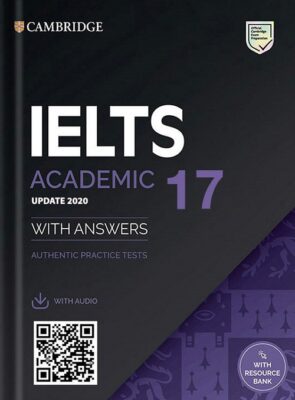Bộ đề thi Cambridge IELTS 17 được ra mắt vào tháng 6/2022 bởi nhà xuất bản Cambridge. Đây là cuốn sách kinh điển dành cho những bạn đang chuẩn bị bước vào kỳ thi IELTS. Vì vậy, mình sẽ chia sẻ với các bạn những bí quyết để sử dụng bộ Cambridge IELTS 17 nhằm giúp bạn đạt kết quả tốt nhất ở các phần thi Nghe – Đọc – Viết – Nói.
1. Giới thiệu bộ đề thi Cambridge IELTS 17

Bộ đề Cambridge IELTS 17 bao gồm 4 đề thi thử cho cả 4 kỹ năng Nghe – Đọc – Viết – Nói. Điểm nổi bật của cuốn sách là mỗi đề thi thử đều được biên soạn một cách cẩn thận và có format giống đề thi thật nhất có thể.
| Các phần chính | Nội dung |
| Introduction | Đưa ra một số thông tin cơ bản liên quan đến cuốn sách. Giới thiệu format của IELTS Academic và IELTS General Training |
| Practice Test | Cung cấp các đề thi chất lượng với format giống như các bài thi thật cho cả 4 kỹ năng Nghe – Đọc – Viết – Nói) |
| Audioscripts | Đưa ra transcript cho bài Nghe |
| Listening and Reading Answer Keys | Đưa ra đáp án cho bài Nghe và bài Đọc |
| Sample Writing Answer | Đưa ra các đáp án mẫu cho bài viết (band điểm dao động 5.5 – 7.5) |
Tải Cambridge IELTS 17 PDF&Audio
2. Hướng dẫn luyện đề Cambridge IELTS 17
Cũng như các bộ sách trước đây, Cambridge IELTS 17 cung cấp 100% đề thi nên sẽ rất phù hợp với những bạn có nhu cầu luyện đề để chuẩn bị tham gia kỳ thi (giai đoạn ôn luyện cấp tốc khoảng 1-3 tháng trước khi thi).
Bạn cần có IELTS Band 3.5 trở lên để học bộ sách này vì ở mức độ này bạn đã có một nền tảng cơ bản về ngữ pháp và từ vựng. Ngoài ra, mình giới thiệu cho các bạn bộ sách IELTS Collins Classic giúp tạo nền tảng vững chắc trước khi luyện đề thi.
Sau đây, mình sẽ chia sẻ những phương pháp đã từng được kiểm chứng là rất hiệu quả để giúp các bạn khai thác triệt để bộ Cambridge IELTS 17 này nhé.
2.1. Luyện nghe với Cambridge IELTS 17
Trong bài thi nghe IELTS các bạn sẽ phải thực hiện 4 phần trong thời gian 40 phút. Dưới đây là audio của bài nghe Part 1 mình lấy trong bộ sách Cambridge IELTS 17 để minh họa:
Hiện Audioscript
PETER: Hello?
JAN: Oh hello. My name’s Jan. Are you the right person to talk to about the Buckworth Conservation Group?
PETER: Yes, I’m Peter. I’m the secretary.
JAN: Good. I’ve just moved to this area, and I’m interested in getting involved. I was in a similar group where I used to live. Could you tell me something about your activities, please?
PETER: Of course. Well, we have a mixture of regular activities and special events. One of the regular ones is trying to keep the beach free of litter. A few of us spend a couple of hours a month on it, and it’s awful how much there is to clear. I wish people would be more responsible and take it home with them.
JAN: I totally agree. I’d be happy to help with that. Is it OK to take dogs?
PETER: I’m afraid not, as they’re banned from the beach itself. You can take them along the cliffs, though. And children are welcome. JAN: Right.
PETER: We also manage a nature reserve, and there’s a lot to do there all year round. For example, because it’s a popular place to visit, we spend a lot of time looking after the paths
Ẩn Audioscript
- Trong mỗi phần của bài nghe, bạn sẽ có khoảng một phút để đọc lướt tất cả các câu hỏi. Quan trọng nhất là sự tập trung để hiểu các ý chính và gạch chân các keyword quan trọng.
- Sau khi hoàn thành bài nghe, bạn nên dành khoảng 15-20 phút để check đáp án và kiểm tra lại audio script. Việc đọc hiểu và phân tích audio script sẽ giúp bạn hiểu được tại sao mình làm sai và tránh được những cái “bẫy” trong IELTS Listening.
- Bạn cũng cần chú ý cách paraphrase các cụm từ trong câu hỏi và trong audio bài nghe. Việc học từ vựng thông qua audio script không chỉ giúp bạn luyện nghe IELTS tốt hơn mà còn bổ trợ cho cả 3 kỹ năng đọc, viết và nói.
- Hãy chia nhỏ bài nghe để nghe đi nghe lại nhiều lần. Mỗi lần nghe lại, bạn sẽ học được một điều gì đó mới và dần dần kỹ năng nghe của bạn được cải thiện lên rất nhiều so với khi bạn chỉ nghe một lần.
2.2. Luyện đọc với Cambridge IELTS 17

Trong bài Reading, bạn có 3 passage với thời gian để làm bài 60 phút. Bạn có thể phân bổ thời gian làm bài 15/20/25 phút cho 3 bài đọc, nếu đã mất quá nhiều thời gian cho 1 passage, hãy nhanh chóng chuyển sang bài tiếp theo.
- Trong khi đọc, bạn dùng bút chì để gạch chân các keywords kết hợp với Skimming và Scanning. Luyện tập kỹ năng Skimming và Scanning rất quan trọng vì bạn sẽ không thể đủ thời gian để đọc từng chữ, từng câu.
Mời các bạn tham khảo bài đọc sau đây trong sách:
READING PASSAGE 1
You should spend about 20 minutes on Questions 1-13 which are based on Reading Passage 1.
Xem thêm
The development of the London underground railway
In the first half of the 1800s, London’s population grew at an astonishing rate, and the central area became increasingly congested. In addition, the expansion of the overground railway network resulted in more and more passengers arriving in the capital. However, in 1846, a Royal Commission decided that the railways should not be allowed to enter the City, the capital’s historic and business centre. The result was that the overground railway stations formed a ring around the City. The area within consisted of poorly built, overcrowded slums and the streets were full of horse-drawn traffic. Crossing the City became a nightmare. It could take an hour and a half to travel 8 km by horse-drawn carriage or bus. Numerous schemes were proposed to resolve these problems, but few succeeded.
Amongst the most vocal advocates for a solution to London’s traffic problems was Charles Pearson, who worked as a solicitor for the City of London. He saw both social and economic advantages in building an underground railway that would link the overground railway stations together and clear London slums at the same time. His idea was to relocate the poor workers who lived in the inner-city slums to newly constructed suburbs, and to provide cheap rail travel for them to get to work. Pearson’s ideas gained support amongst some businessmen and in 1851 he submitted a plan to Parliament. It was rejected, but coincided with a proposal from another group for an underground connecting line, which Parliament passed.
The two groups merged and established the Metropolitan Railway Company in August 1854. The company’s plan was to construct an underground railway line from the Great Western Railway’s (GWR) station at Paddington to the edge of the City at Farringdon Street – a distance of almost 5 km. The organisation had difficulty in raising the funding for such a radical and expensive scheme, not least because of the critical articles printed by the press. Objectors argued that the tunnels would collapse under the weight of traffic overhead, buildings would be shaken and passengers would be poisoned by the emissions from the train engines. However, Pearson and his partners persisted.
The GWR, aware that the new line would finally enable them to run trains into the heart of the City, invested almost £250,000 in the scheme. Eventually, over a five-year period, £1m was raised. The chosen route ran beneath existing main roads to minimise the expense of demolishing buildings. Originally scheduled to be completed in 21 months, the construction of the underground line took three years. It was built just below street level using a technique known as ‘cut and cover’. A trench about ten metres wide and six metres deep was dug, and the sides temporarily held up with timber beams. Brick walls were then constructed, and finally a brick arch was added to create a tunnel. A two-metre-deep layer of soil was laidon top of the tunnel and the road above rebuilt.
The Metropolitan line, which opened on 10 January 1863, was the world’s first underground railway. On its first day, almost 40,000 passengers were carried between Paddington and Farringdon, the journey taking about 18 minutes. By the end of the Metropolitan’s first year of operation, 9.5 million journeys had been made.
Even as the Metropolitan began operation, the first extensions to the line were being authorised; these were built over the next five years, reaching Moorgate in the east of London and Hammersmith in the west. The original plan was to pull the trains with steam locomotives, using firebricks in the boilers to provide steam, but these engines were never introduced. Instead, the line used specially designed locomotives that were fitted with water tanks in which steam could be condensed. However, smoke and fumes remained a problem, even though ventilation shafts were added to the tunnels.
Despite the extension of the underground railway, by the 1880s, congestion on London’s streets had become worse. The problem was partly that the existing underground lines formed a circuit around the centre of London and extended to the suburbs, but did not cross the capital’s centre. The ‘cut and cover’ method of construction was not an option in this part of the capital. The only alternative was to tunnel deep underground.
Although the technology to create these tunnels existed, steam locomotives could not be used in such a confined space. It wasn’t until the development of a reliable electric motor, and a means of transferring power from the generator to a moving train, that the world’s first deep-level electric railway, the City & South London, became possible. The line opened in 1890, and ran from the City to Stockwell, south of the River Thames. The trains were made up of three carriages and driven by electric engines. The carriages were narrow and had tiny windows just below the roof because it was thought that passengers would not want to look out at the tunnel walls. The line was not without its problems, mainly caused by an unreliable power supply. Although the City & South London Railway was a great technical achievement, it did not make a profit. Then, in 1900, the Central London Railway, known as the ‘Tuppenny Tube’, began operation using new electric locomotives. It was very popular and soon afterwards new railways and extensions were added to the growing tube network. By 1907, the heart of today’s Underground system was in place.
Thu gọn
- Sau khi đã làm bài, hãy check các đáp án và tìm xem lỗi sai ở đâu (do làm không kịp, do không hiểu từ vựng, do hiểu sai vấn đề,…). Từ đó, bạn có thể rút ra những vấn đề cần khắc phục.
- Cuối cùng, bạn cần học thuộc các từ mới trong bài Reading để mở rộng vốn từ của mình.
2.3. Luyện viết với Cambridge IELTS 17

Trong 4 kỹ năng thì đây là phần khó để tăng điểm nhất nên bạn không có cách nào khác ngoài luyện tập, luyện tập và luyện tập.
- Có mục tiêu rõ ràng và duy trì việc học hàng tuần. Ví dụ: mỗi tuần viết 1, 2, 3 bài tùy theo thời gian của bạn.
- Lập dàn ý cho từng bài viết, đặc biệt là Writing Task 2. Ví dụ: Overall sẽ có gì? Feature 1, feature 2 là gì?
- Chuẩn bị sẵn các template (mẫu viết) để không bị hoang mang và có thể khi làm có thể triển khai ngay.
- Cần kiểm tra lỗi chính tả và nên nhờ người chấm Writing có trình độ để giúp bạn chấm và chỉ ra điểm bạn cần khắc phục.
- Đọc thêm tài liệu tiếng Anh giúp bạn không bị bất ngờ với các chủ đề khó.
2.4. Luyện nói với Cambridge IELTS 17

Một số gợi ý để học Speaking hiệu quả mà bạn có thể áp dụng:
- Thu âm bài nói của mình sau đó nghe lại để tìm ra lỗi sai, cách phát âm chưa đúng để khắc phục.
- Luyện tập trước gương để điều chỉnh khẩu hình và body language.
- Thực hành với một partner để tránh sự nhàm chán. Hai bạn có thể giúp nhau để góp ý cho nhau những lỗi sai căn bản.
- Ngoài các bài mẫu trong sách Cambridge 17, hãy chủ động tiếp cận tiếng Anh một cách tự nhiên hơn như qua phim ảnh, mạng xã hội, giúp luyện phản xạ và cải thiện cách dùng từ, cách diễn đạt của mình trong những tình huống thực tế.
Trên đây, mình đã chia sẻ với các bạn những phương pháp thực hành các kỹ năng Nghe – Đọc – Viết – Nói với cuốn Cambridge IELTS 17. Nếu bạn cần nhiều sách hơn để tham khảo, hãy lướt qua chuyên mục Luyện thi IELTS trên Lingolala.vn! Chúc các bạn học tập tốt và mãi yêu thích tiếng Anh!
